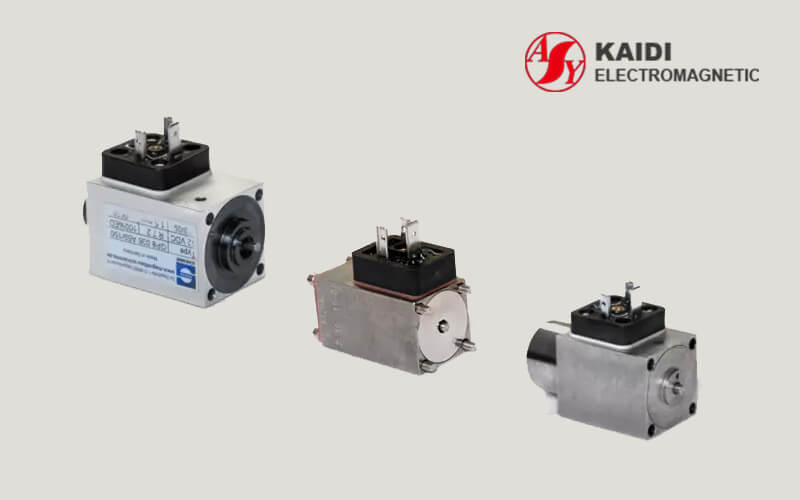The solenoid is a device that generates electromagnetism by electrifying. It mainly consists of armature core, solenoid tube and solenoid coil. The coil is usually wound around the outside of the core. When the armature core is inserted inside the electrified solenoid tube, it will be magnetized by the field of the electrified solenoid tube, and then transformed into a magnetic body, which greatly enhances the solenoid’s magnetism due to the superposition of two magnetic fields. Generally, we make the armature core into hoof type. But it should be noted that the wind direction of the coil on the core needs to be clockwise on one side and counterclockwise on the other. If the wind direction is the same, the magnetization effect of the two coils on the core will cancel each other, so that the core does not show magnetism. In addition, in order to make the solenoid degaussing immediately after the power is cut off, we often adopt soft iron as the raw material rather than steel. Otherwise, once the steel is magnetized, it will remain magnetic for a long time without demagnetization, and its magnetic strength can’t be controlled by the magnitude of the current, thus losing the merits of the solenoid.
The solenoid is widely used in our life because of its variety of categories, which brings us a lot of conveniences. Next, we will talk about its application and how to choose the solenoid.
How to Choose the Solenoid
The solenoid appears in every aspect of our life, correspondingly there will be many different types in the market for us to choose. Before we plan to buy it, we need to know something about it so as to clear which solenoid will meet our needs. There are some selection conditions as follow:
Output Requirement
Stroke & Force: the stroke is the distance from the slide bar to the armature core or the distance from which the solenoid acts. While the force is the attractive force produced by the solenoid during a certain stroke after it is electrified. Their general rule is that the greater the stroke, the less the force.
Response Time: it is the time from the solenoid is electrified to the time required for the slide bar to complete the displacement.
Maximum power-on time: the solenoid will heat up when it is energized. The longest power-on time and the power of the solenoid determine the temperature rise, while the temperature rise and the temperature of the working environment determine the selection of the insulation grade of the solenoid’s material.
Input Conditions
Power Type: the power supply can be divided into alternating current and direct current (constant voltage source, constant current source, battery, dry battery, DC generator and capacitor).
Diodes for Rectification: in the application of solenoid, if the current power supply is AC, it needs to be converted to DC by a rectifier. And in principle, it should be designed as full-wave rectification. The reverse peak voltage of the rectifier element should be three times the driving voltage of the electromagnet.
Environmental factors and Service Life
Environmental factors and service life are both important considerations when selecting materials and surface treatment methods for the solenoid. Environmental factors include temperature, humidity, magnetic fields, the pollution or corrosion of gas, liquid or solid, vibration, impact, etc.
Connection Mode
Setup Connection: external bolt, screw holes in the solenoid housing, slot embedding.
Power Connection: lead, lead + terminal, 187 fast connection pin.
All the selection conditions we mentioned above are the things we should know when we are choosing the solenoid so that what we choose can meet our actual need.
Applications of the solenoid
We all know that solenoid product is used everywhere in our daily life. It can be divided into DC solenoid and AC solenoid two major types. But if we classify them by purpose, the solenoid can be divided into traction solenoid, lifting solenoid, brake solenoid, etc.
Traction solenoid is mainly used for the traction of mechanical devices and the opening or closing of various valves so as to perform automatic control tasks.
Lifting solenoid is mainly used as a lifting device to lift ingots, steel, iron sand and other ferromagnetic materials.
Brake solenoid is the key part for braking motor to achieve the purpose of accurate parking.
In addition, the solenoid is widely adopted in the medical equipment industry and scientific instrument industry, such as sphygmomanometer, orthodontic machine, pulse apparatus, blood clarifier, etc. And it is also applied in home appliances and home fitness equipment, like coffee machine, water dispenser, rice cooker, air conditioner, washing machine, refrigerator, massage chair and all kinds of beauty apparatus. In the automobile industry, the solenoid is regarded as an indispensable part in the HID automotive xenon headlights, telescopic lights, power converters, exhaust box, gear shifter, solenoid valve, trunk lock, belt lock and other automobile components. Therefore, we can see that, although the solenoid is small, it has a wide range of applications, covering a wide range of industries, and the market prospects of solenoids are very promising!
Kaidi is a solenoid supplier from China, we provide various kind of solenoid and solenoid coils, such as Rexroth solenoid coil, Yuken solenoid coil, Vickers solenoid coil, Parker solenoid coil and other custom solenoid or solenoid coil according to your drawing or samples. If you are interested in our products, please feel free to contact us.
